When novananoenzymes meet biomedicine
1. Single-atom nanoenzymes for photodynamic therapy [1]
Photodynamic therapy (PDT) refers to a photosensitizer that generates a large amount of reactive oxygen species (ROS) after receiving a certain wavelength of laser irradiation to achieve oxidative damage to cancer cells. It is widely used in cancer due to its strong controllability and low side effects. Treatment and other fields. This therapy relies on local O2 molecules to produce highly cytotoxic singlet oxygen (1O2), but the hypoxic microenvironment of solid tumors will affect the therapeutic effect of photodynamic therapy. In order to solve the above problems, the research team of Nanyang Technological University Zhao Yanli designed a safe and efficient self-assembled nano-preparation, single-atom nanoenzyme (OxgeMCC-r). The researchers used one-step self-assembly technology to fix ruthenium atoms with catalase-like activity in porous Mn3[Co(CN)6]2 materials, while coating the photosensitizer Ce6 in MOFs materials. The composite nanoenzyme has controllable size and morphology, and high loading capacity. OxgeMCC-r nanozyme catalyzes endogenous hydrogen peroxide to generate oxygen at the tumor site, effectively alleviating the hypoxic environment inside the tumor, and significantly improving the effect of photodynamic therapy. Both in vitro and in vivo experiments have proved OxgeMCC-r nano The enzyme has an excellent anti-tumor effect. At the same time, the Mn2+ in the composite nanoenzyme can be used for T1 magnetic resonance imaging capabilities. OxgeMCC-r SAE has high Ce6 loading capacity, superior catalytic performance and in vivo tracking and imaging capabilities. It will be a promising anti-tumor drug and promote the further development of different single-atom nanoenzymes in the field of catalytic nanomedicine.

Figure 1. Schematic diagram of the synthesis of single-atom nanozyme OxgeMCC-r.
2. Semiconductor nanoenzymes are used for photothermal iron treatment [2]
Iron therapy has broad application prospects in cancer treatment. The principle is that the Fenton reaction mediated by metal ions divalent iron ions converts hydrogen peroxide in the microenvironment of cancer cells into toxic hydroxyl free radicals, thereby realizing cancer treatment. Cell damage. However, the low catalytic efficiency of the Fenton reaction in the tumor microenvironment limits the further application of materials to a certain extent. In order to solve the above problems, Nanyang Technological Universitys Pu Kanyi research team synthesized a semiconductor nanoenzyme (HSN) based on organic semiconductor polymer (pTBCB-PEG) and Fe2+ complex for photothermal iron therapy. The design of the nanocomposite enzyme enhances its imaging effect in the second zone of the near-infrared. Under the irradiation of near-infrared light, HSM causes the death of cancer cells through the photothermal effect. On the one hand, it enhances the Fenton reaction and promotes the decomposition of hydrogen peroxide and the toxic hydroxyl group. The formation of free radicals. On the other hand, the free radicals produced by decomposition decompose 42 nm nanoparticles into 1.7 nm tiny particles, which increases their intratumoral permeability and greatly enhances the anti-tumor ability and anti-tumor ability of nanozymes under the synergistic effect The ability to inhibit tumor metastasis was obtained in vivo in mice. This research not only increased the tissue depth of non-invasive photothermal treatment to a new level (9 mm), but also revealed the mechanism of photothermal iron therapy. The most important thing is that the scope of application of nanoenzymes can be extended to other deep tissue diseases, such as neurodegenerative diseases, which provides a broader biomedical prospect for new nanoenzymes.
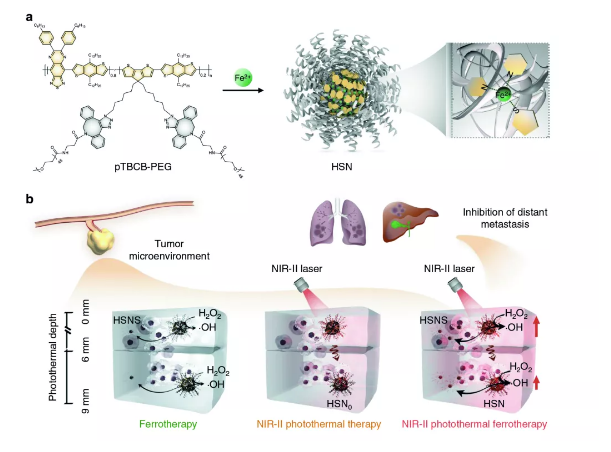
Figure 2. The schematic diagram of the synthesis of semiconductor nanozymes (HSN) compared with HSN-mediated photothermal therapy and iron therapy.
3. Ultrafine nanoenzymes are used for enhanced sonodynamic therapy [3]
Sonodynamic therapy refers to a new non-invasive treatment method that uses the extremely strong tissue penetration of ultrasound. When the sonosensitizer reaches the target point, it generates active oxygen under the action of ultrasound, so as to achieve precise and controllable therapeutic effects. Titanium dioxide is a widely studied sonosensitizer with high stability and low toxicity. However, the active oxygen quantum yield of pure titanium dioxide nanoparticles is low, which weakens its therapeutic effect. Based on this, the research team of Cheng Liang of Soochow University designed a titanium monoxide nanorod (PEG-TiO1+x NRs) with excellent sound sensitivity and horseradish peroxide activity through a seed-mediated growth mechanism. Its hypoxic structure This leads to a stronger ability to produce reactive oxygen species. Whats more interesting is that PEG-TiO1+x NRs have the properties of nanoenzymes, which can efficiently catalyze endogenous hydrogen peroxide to produce hydroxyl free radicals and induce apoptosis and necrosis of cancer cells. Dynamic and chemical dynamics are effectively inhibited under synergistic treatment, and its inhibitory effect is significantly better than that of titanium dioxide nano sonosensitizer. At the same time, PEG-TiO1+x NRs nanoenzyme has no obvious toxic and side effects, which provides a new idea for the design of new sonosensitizers It has broad application prospects in the field of tumor therapy.
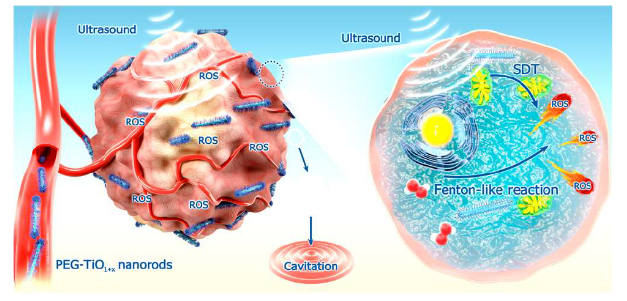
Figure 3. Schematic diagram of PEG-TiO1+x NRs nanoparticles used as a sonosensitizer for sonodynamic and chemodynamic therapy.
4. Nanoenzyme gel is used for fluorescence imaging [4]
As a kind of hydrophilic gel with three-dimensional network structure and good biocompatibility, hydrogels are used in the field of biomedicine. Encapsulation of biomimetic enzymes and natural enzymes in hydrogel systems has become a hot topic in biological research, because it can protect enzymes from structural changes and possible subsequent inactivation, ensuring higher loading and better substrate fluidity , So as to achieve efficient catalysis. Although there have been good research results in the preparation of large gels, it is still a challenge to modify or assemble hybrid nanogels in a limited nanospace. Based on this, the research team of Wang Qigang of Tongji University in this paper is based on the transition metal Fe (II) ion coordination biocompatible acryloyl lysine polymer brush, using enzyme-catalyzed atom transfer radical polymerization (ATRPase) method to prepare metal crosslinks Polymer nanogels (MPGs) system. The single-atom, highly-dispersed iron ions in MPGs are not only the high-efficiency cross-linking agent of the gel network, but also the multi-enzyme mimic active center of superoxide dismutase (SOD) and peroxidase (POD) activities. The catalytic activity of the enzyme is comparable, and the thermal stability is higher than that of molecular enzyme mimics and natural horseradish peroxidase. Cell and animal experiments have confirmed that MPGs nanoenzyme gel can achieve high-efficiency biofluorescence imaging in response to reactive oxygen species, and has good biocompatibility. It is expected to be further applied to fluorescence imaging, drug delivery and other medical fields.
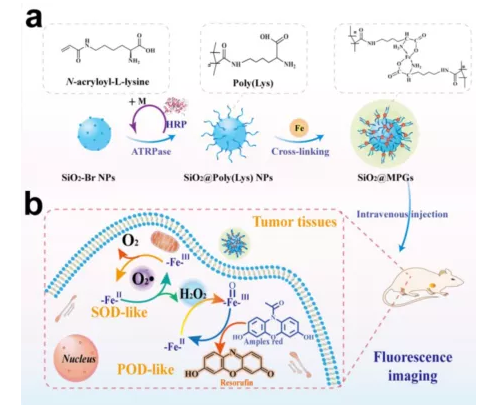
Figure 4. A schematic diagram of using enzyme-catalyzed atom transfer radical polymerization to prepare MPGs gel and for fluorescence imaging.
5. Platinum nanozyme is used to determine the total antioxidant level in saliva [5]
Biomarkers related to redox imbalance and oxidative stress play an important role in human diseases. Total antioxidant capacity (TAC) is an important physiological parameter. However, antioxidant testing requires complex equipment and procedures, and they There are areas to be optimized for accuracy and sensitivity. Recently, the research team of Pier Paolo Pompa of the Italian Institute of Technology combined platinum nanozymes with hydroxyl radical probes, and used the competitive reaction between the hydroxyl radicals on the surface of the nanozymes and the TMB chromogenic substrate and antioxidant AH. Single electron transfer (SET) and hydrogen atom transfer (HAT) reactions can detect almost all physiological antioxidant species. Nanoenzyme and saliva are mixed for 5 minutes and then tested by colorimetric reaction, which realizes fast and accurate detection and observation by naked eyes or mobile phones. This method has created a new method for detecting antioxidant capacity, and has the advantages of high efficiency, convenience, wide range and accuracy, and has great practical application prospects.
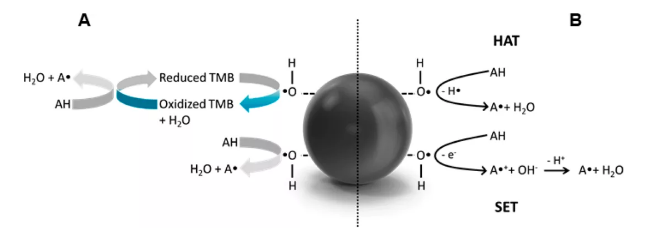
Figure 5. Schematic diagram of the principle of platinum nanozymes used to detect antioxidant capacity.
6. Ultra-small copper-based nanoenzymes for active oxygen scavenging [6]
Oxidative stress is related to many acute and chronic inflammatory diseases, but the current clinical treatment methods are limited. The development of enzyme-simulating nanomaterials with good active oxygen scavenging ability and biocompatibility is an effective way to treat active oxygen-related inflammation. The Mao Zhengwei research team of Zhejiang University reported a simple and effective one-step method for the development of ultra-small Cu5.4O nanoparticles, which have multiple mimic enzyme activities and broad-spectrum ROS clearance capabilities, which can be used to treat ROS-related diseases. Cu5.4O nanozyme has the properties of catalase, superoxide dismutase and glutathione-like peroxidase at the same time. It exhibits cytoprotective effect on ROS-mediated damage at very low doses, and significantly improves acute Therapeutic effect of kidney injury, acute liver injury and wound healing. At the same time, the ultra-small size of Cu5.4O nanoenzyme makes it clear in the kidney quickly, ensuring biocompatibility. The protective effect and good biocompatibility of Cu5.4O nanozymes will promote the clinical treatment of ROS-related diseases and the development of next-generation nanozymes.
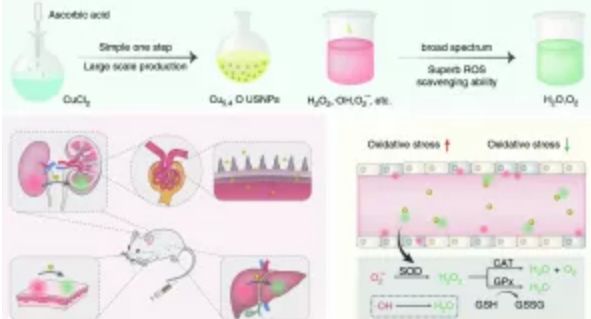
Figure 6. Schematic diagram of the synthesis of Cu5.4O nanozyme and its use in the treatment of ROS-related diseases.
7. Summary and Outlook
Nanoenzymes are the original scientific research achievements of the Chinese, and Chinese scientists have always been at the forefront of the world and have achieved a series of fruitful results. The outstanding feature of nanoenzymes is their unique catalytic activity and unique physical and chemical properties as inorganic nanomaterials. At the same time, they can use the ever-developing nanotechnology to control their size and surface modification, and regulate their enzyme activity. With the implementation of the Healthy China strategy, nanoenzymes will collide with biomedicine to create new sparks. Peoples continuous development of nanoenzymes and the improvement of their catalytic mechanisms will promote their broader applications in biomedicine. Together, we look forward to nanoenzymes creating new miracles in the fields of major disease diagnosis, cancer treatment, biochemical detection, biosensing and anti-oxidation.
The company provides the following nanoenzyme products
+86-18915413828(WhatsApp&WeChat)
Previous: Biomimetic structural
Next: Nature communications


